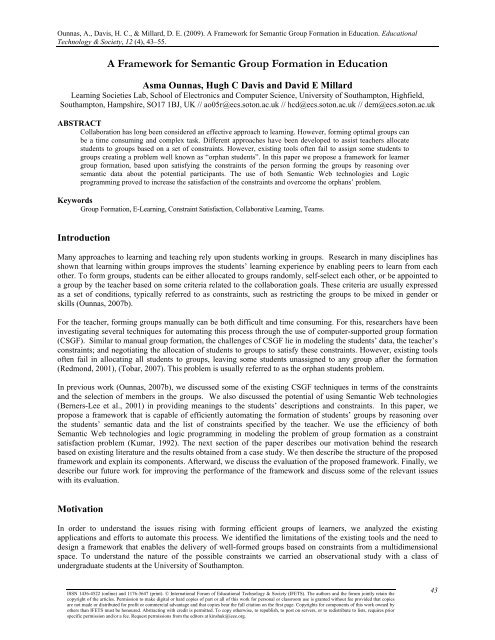October 2009 Volume 12 Number 4 - Educational Technology ...
October 2009 Volume 12 Number 4 - Educational Technology ...
October 2009 Volume 12 Number 4 - Educational Technology ...
Create successful ePaper yourself
Turn your PDF publications into a flip-book with our unique Google optimized e-Paper software.
Ounnas, A., Davis, H. C., & Millard, D. E. (<strong>2009</strong>). A Framework for Semantic Group Formation in Education. <strong>Educational</strong><br />
<strong>Technology</strong> & Society, <strong>12</strong> (4), 43–55.<br />
A Framework for Semantic Group Formation in Education<br />
Asma Ounnas, Hugh C Davis and David E Millard<br />
Learning Societies Lab, School of Electronics and Computer Science, University of Southampton, Highfield,<br />
Southampton, Hampshire, SO17 1BJ, UK // ao05r@ecs.soton.ac.uk // hcd@ecs.soton.ac.uk // dem@ecs.soton.ac.uk<br />
ABSTRACT<br />
Collaboration has long been considered an effective approach to learning. However, forming optimal groups can<br />
be a time consuming and complex task. Different approaches have been developed to assist teachers allocate<br />
students to groups based on a set of constraints. However, existing tools often fail to assign some students to<br />
groups creating a problem well known as “orphan students”. In this paper we propose a framework for learner<br />
group formation, based upon satisfying the constraints of the person forming the groups by reasoning over<br />
semantic data about the potential participants. The use of both Semantic Web technologies and Logic<br />
programming proved to increase the satisfaction of the constraints and overcome the orphans’ problem.<br />
Keywords<br />
Group Formation, E-Learning, Constraint Satisfaction, Collaborative Learning, Teams.<br />
Introduction<br />
Many approaches to learning and teaching rely upon students working in groups. Research in many disciplines has<br />
shown that learning within groups improves the students’ learning experience by enabling peers to learn from each<br />
other. To form groups, students can be either allocated to groups randomly, self-select each other, or be appointed to<br />
a group by the teacher based on some criteria related to the collaboration goals. These criteria are usually expressed<br />
as a set of conditions, typically referred to as constraints, such as restricting the groups to be mixed in gender or<br />
skills (Ounnas, 2007b).<br />
For the teacher, forming groups manually can be both difficult and time consuming. For this, researchers have been<br />
investigating several techniques for automating this process through the use of computer-supported group formation<br />
(CSGF). Similar to manual group formation, the challenges of CSGF lie in modeling the students’ data, the teacher’s<br />
constraints; and negotiating the allocation of students to groups to satisfy these constraints. However, existing tools<br />
often fail in allocating all students to groups, leaving some students unassigned to any group after the formation<br />
(Redmond, 2001), (Tobar, 2007). This problem is usually referred to as the orphan students problem.<br />
In previous work (Ounnas, 2007b), we discussed some of the existing CSGF techniques in terms of the constraints<br />
and the selection of members in the groups. We also discussed the potential of using Semantic Web technologies<br />
(Berners-Lee et al., 2001) in providing meanings to the students’ descriptions and constraints. In this paper, we<br />
propose a framework that is capable of efficiently automating the formation of students’ groups by reasoning over<br />
the students’ semantic data and the list of constraints specified by the teacher. We use the efficiency of both<br />
Semantic Web technologies and logic programming in modeling the problem of group formation as a constraint<br />
satisfaction problem (Kumar, 1992). The next section of the paper describes our motivation behind the research<br />
based on existing literature and the results obtained from a case study. We then describe the structure of the proposed<br />
framework and explain its components. Afterward, we discuss the evaluation of the proposed framework. Finally, we<br />
describe our future work for improving the performance of the framework and discuss some of the relevant issues<br />
with its evaluation.<br />
Motivation<br />
In order to understand the issues rising with forming efficient groups of learners, we analyzed the existing<br />
applications and efforts to automate this process. We identified the limitations of the existing tools and the need to<br />
design a framework that enables the delivery of well-formed groups based on constraints from a multidimensional<br />
space. To understand the nature of the possible constraints we carried an observational study with a class of<br />
undergraduate students at the University of Southampton.<br />
ISSN 1436-4522 (online) and 1176-3647 (print). © International Forum of <strong>Educational</strong> <strong>Technology</strong> & Society (IFETS). The authors and the forum jointly retain the<br />
copyright of the articles. Permission to make digital or hard copies of part or all of this work for personal or classroom use is granted without fee provided that copies<br />
are not made or distributed for profit or commercial advantage and that copies bear the full citation on the first page. Copyrights for components of this work owned by<br />
others than IFETS must be honoured. Abstracting with credit is permitted. To copy otherwise, to republish, to post on servers, or to redistribute to lists, requires prior<br />
specific permission and/or a fee. Request permissions from the editors at kinshuk@ieee.org.<br />
43

















